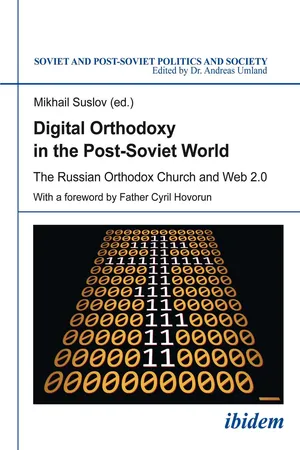![]()
Chapter 1.
The Medium for Demonic Energies:
‘Digital Anxiety’ in the Russian Orthodox Church
Mikhail Suslov
Uppsala Center for Russian and Eurasian Studies, Uppsala University
Introduction
In the last two decades religions around the globe successfully expanded into the internet, thereby questioning basic tenets of the secularism theory.[1] New ways have been uncovered in which digital technology could be and is being integrated with religious tradition. Digital technology has been increasingly seen as a new platform for the Church’s mission, as well as a new communicative environment, in which people can build up religious communality, establish their religious identities, obtain religious experience (Campbell 2010b; Stout 2012) and develop ‘cybertheology’ (e.g. Spadaro 2014). In some religions, including Eastern Orthodox Christianity, communication lies in the center of their theological reasoning. For example, Orthodox Trinitarian theology conceives of God as a communion of three hypostases. Metropolitan of Pergamon Ioannis Zizioulas, one of the most influential Orthodox theologians of our time, argues that the mystery of the Trinity ‘points to a way of being which precludes individualism and separation… The “one” not only does not precede—logically or otherwise—the “many”, but, on the contrary, requires the “many” from the very start in order to exist’ (Zizioulas 2006: 159). Communication from this perspective is fundamental for the development of religious identity (see also: Zizioulas 1985: 110; cf. Baab 2012: 277–291). This theological insight exhibits one of the possible ways for the Church to make sense of new media as a game-changer in human communication. One scholar has expressed this idea, that different media in religious life are like different translations of the Bible (Hipps 2009: 24). They are essentially about one and the same thing, but small differences can result in tectonic shifts, similarly to how the revision of liturgical books in the mid-17th century led to the schism in the Russian Church. More than this, religion itself is a kind of medium, and its manifestations are always mediated: by the written word, oral speech, icons or liturgy as a synthesis of many media (Engelke 2010: 371–379; Khroul 2012: 8–9; Vries 2001). So media are by no means irrelevant to the ROC and its doctrine, nor are they unimportant for shaping one’s religious identity, and for struggling for its recognition.
Possibilities, which computer-mediated communication (thereafter CMC) has created for the Russian Orthodoxy, are gigantic and historically unique; CMC gives voice to a subculture, which was almost voiceless during the Soviet period, and provides an instrument for limitless missionary activity. Keeping the debates on (post-) secularism in due consideration, this paper argues that Russian Orthodoxy’s uneasy co-existence with the internet is anchored in the incongruity between the regime of post-secularism, in which today’s ‘digital religion’ exists, and the ROC’s striving to restore pre-secular conditions. Following Habermas’ line of thinking about prerequisites for post-secularism (quoted in Ziebertz and Riegel 2009: 300): acceptance of plurality, rational reasoning as a communicative strategy and acknowledgement of human rights as the fundamental value, we can suggest that the ROC is trying to instrumentalize the internet as a medium for exactly the opposite messages: the monopoly on moral judgment, the privileging of faith over reason and the relativisation of the human rights’ doctrine.
New media, however, have their own communicative logic and political agenda, which may or may not facilitate democratization of the public sphere (e.g. Gorham 2014; Paulsen and Zvereva 2014; Roesen and Zvereva 2014; Schmidt and Teubiner 2009; Uffelmann 2014). They do definitely spur grassroots activism as well as ‘cynical reason’ (Sloterdijk 1987) and ‘liquid’ forms of social sensibility (Bauman 2000). The deepest irony here is that providing unlimited access to the discourse, the internet seems to undermine something dear to the hearts of the Orthodox Christians, namely the hierarchy of knowledge, and the underlying hierarchy of power. To just have access to the discourse is not important for them, because they believe that they already have an exclusive access to the ‘real’ and the only important knowledge—about God. This means that the internet devalues their treasure and refashions their authority (cf. Hjarvard 2008). Russian Orthodoxy shares these premonitions with some fundamentalist religions, fearing that digital technologies could profane sacral truths and belittle the religious authority of the Church hierarchy (Barzilai-Nahon and Barzilai 2005: 25–40; Howard 2011).
At this juncture we can see the mechanism of the ‘digital anxiety’, powered by the fear of losing control over the identity of the self and the (collective and individual) other, on the one hand, and the attempt to ‘securitize’ the religious identity, many of whose aspects are being perceived as endangered in the age of new media. The logic of securitization produces a series of moral panics about CMC in order to reinforce the grid of values of this seemingly vulnerable religious ‘self’.
The supporting primary sources for this research come mostly from qualitative analysis of the blogs of Orthodox priests and activists, official documents of ROC and statements of the Church highest clerics as well as several open-ended questionnaires.[2] The ROC has no official policy document on the internet, so opinions may vary greatly among the Orthodox clergy. This article tries not...
